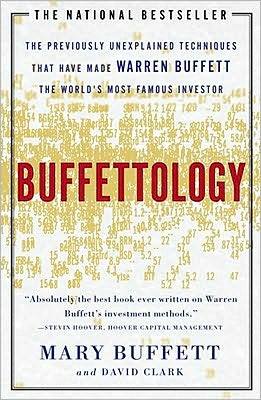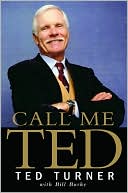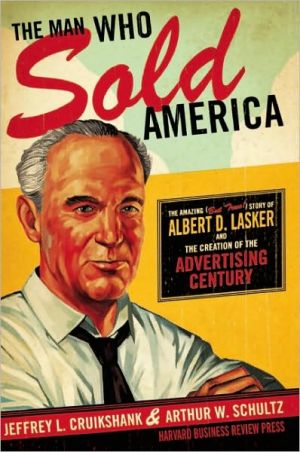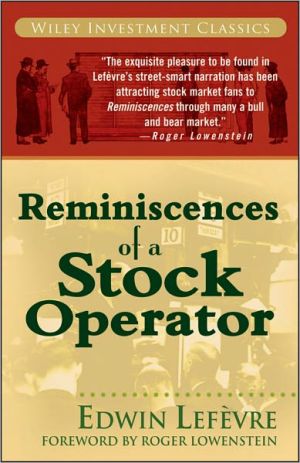Buffettology: The Previously Unexplained Techniques That Have Made Warren Buffett The Worlds
HOW WARREN BUFFETT DID IT — AND HOW YOU CAN TOO\ In the world of investing, the name Warren Buffett is synonymous with success and prosperity. Building from the ground up, Buffett chose wisely and picked his stocks with care, in turn amassing the huge fortune for which he is now famous. Mary Buffett, former daughter-in-law of this legendary financial genius and a successful businesswoman in her own right, has teamed up with noted Buffettologist David Clark to create Buffettology, a...
Search in google:
The key concepts behind the billionaire investor's investing techniques plus a never-before-published list of 50 companies that Buffett himself has invested in. Business Week A probe inside the head of a financial genius.
From Chapter 2\ How to Use This Book\ Folly and discipline are the key elements of Warren Buffett's philosophy of investing — other people's follies and Warren's discipline. Warren commits capital to investment only when it makes sense from a business perspective. It is business perspective investing that gives him the discipline to exploit the stock market's folly. Business perspective investing is the theme of this book.\ This discipline of investing from a business perspective has made Warren the second richest business person in the world. Currently Warren's net worth is in excess of $20 billion. Warren is the only billionaire who has made it to the Forbes list of the four hundred richest Americans solely by investing in the stock market. Over the last thirty-two years his investment portfolio has produced an average annual compounding rate of return of 23.8%.\ As humans we are susceptible to the herd mentality, and so we often fall victim to the emotional vicissitudes that propel the stock market and feed enormous profits to those who are disciplined, like Warren. When the Dow Jones Industrial Average has just dropped 508 points and all the sheep are jumping ship, it is investing from a business perspective that gives Warren the confidence to step into that pit of fear and greed we call the stock market and start buying. When the stock market soars to the stratosphere, it is the discipline of investing from a business perspective that keeps Warren from foolishly allocating capital to business ventures that have neither hope nor prospects of giving him a decent return on his investment.\ This book is about the discipline of investing only from a business perspective. Together we will explore the origin and evolution of this philosophy. We will delve into the early writings of Warren's mentor Benjamin Graham and the ideas of other financial luminaries of this century, and travel to the present to explore the substance of Warren's philosophy.\ Warren made his fortune investing in the securities of many different types of businesses. His preference is to acquire 100% ownership of an enterprise that has excellent business economics and management. When he is unable to do that, his next choice is to make a long-term minority investment in the common stock of a company that also has excellent business economics and management. What confuses people who are trying to decipher his philosophy is that he also makes investments in long-, medium-, and short-term income securities. And he is a big player in the field of arbitrage.\ The characteristics of the businesses that he is investing in will vary according to the nature of his investment. A company that he is willing to invest in for arbitrage purposes may not be the kind of business in which he wants to make a long-term investment. But regardless of the type of business or the nature of the investment, Warren always uses the basics of business perspective investing as the foundation for his decision.\ Most people have the intellectual capacity to understand Warren's philosophy of investing from a business perspective, but few have the dedication and willingness to work to learn the tools of his craft. The purpose of this book is to lay out, step by step, the foundation of Warren's philosophy and the manner in which he applies it. This book is a tool to facilitate the task of learning, and it is our intention to teach you Warren's philosophy so that you may acquire the skills to practice this discipline yourself.\ Before we start, I would like to introduce a few concepts and terms that will be used throughout the book and give you an idea of where we will be heading as we voyage through the seas of high finance.\ First of all, let's take the term "intrinsic value." Its definition has been debated for the last hundred years. It fits into our scheme because Warren will buy into a business only when it is selling at a price that makes business sense given the business's intrinsic value.\ Determining a business's intrinsic value is a key to deciphering Warren's investment philosophy. To Warren the intrinsic value of an investment is the projected annual compounding rate of return the investment will produce.\ It is this projected annual compounding rate of return that Warren uses to determine if the investment makes business sense. What Warren is doing is projecting a future value for the business, say, ten years out; then he compares the price he is going to pay for the business against the business's future, projected value, and the length of time required for the business to reach that projected value. By using an equation that we will show you later in the book, Warren is able to project the annual compounding rate of return that the investment will produce. The annual compounding rate of return the investment is projected to produce is the value he uses to determine if the investment makes business sense when compared to other investments.\ In its simplest manifestation it works like this: If Warren can buy a share of stock in X Corporation for $10 and can project that in ten years the share will be worth $50, he can then calculate that his projected annual compounding rate of return will be approximately 17.46% for the ten-year period. It is this projected annual compounding return of 17.46% that he will then compare to other investments to determine whether the investment in X Corporation makes business sense.\ You may be wondering: If Warren's intrinsic value model requires a projection of a business's future value, then how does he go about determining that future value?\ That, my friends, is the crux of solving the enigma of Warren's investment philosophy. Just how does one determine the future earnings of a business in order to project its future value and, thus, its intrinsic value? This problem and Warren's method of solving it will be the focus of much of this book.\ In short, Warren focuses on the predictability of future earnings; and he believes that without some predictability of future earnings, any calculation of a future value is mere speculation, and speculation is an invitation to folly.\ Warren will make long-term investments only in businesses whose future earnings are predictable to a high degree of certainty. The certainty of future earnings removes the element of risk from the equation and allows for a sound determination of a business's future value.\ After we have learned what Warren believes are the characteristics of a business with predictable earnings, we will learn how to apply the mathematical calculations he uses for determining the business's intrinsic value and what the return on his investment will be. The nature of the business enterprise and whether it can be bought at a price that will yield a sufficient return will determine the investment's worth and whether or not we are investing from a business perspective.\ Copyright © 1997 by Mary Buffett and David Clark
CONTENTSDisclaimerPART I: THE ART OF BASIC BUFFETTOLOGY1. Before You Begin This Book2. How to Use This Book3. Roots4. Investing from a Business Perspective5. What Is Businesslike Investing?6. Warren's View of Earnings7. The Price You Pay Determines Your Rate of Return8. The Corporation, Stocks, Bonds — a Few Useful Explanations9. Valuing a Business10. The Only Two Things You Need to Know About Business Perspective Investing: What to Buy — and at What Price11. What We Can Learn from Warren's Secret Weapon: The Magic of Compounding12. Determining What Kind of Business You Want to Own13. The Theory of an Expanding Intrinsic Value14. The Mediocre Business15. How to Identify the Excellent Business — the Key to Warren's Good Fortune16. Nine Questions to Help You Determine If a Business Is Truly an Excellent One17. Where to Look for Excellent Businesses18. More Ways to Find a Company You Want to Invest In19. What You Need to Know About the Management of the Company You May Invest In20. When a Downturn in a Company Can Be an Investment Opportunity21. How Market Mechanics Whipsaw Stock Prices to Create Buying Opportunities22. Inflation23. Inflation and the Consumer Monopoly24. A Few Words on Taxation25. The Effects of Inflation and Taxation on the Rate of Return, and the Necessity to Obtain a 15% Return on Your Investment26. The Myth of Diversifications Versus the Concentrated Portfolio27. When Should You Sell Your Investments?28. Warren's Different Kinds of InvestmentsPART II: ADVANCED BUFFETTOLOGY29. The Analyst's Role in AscertainingEarning Power30. The Mathematical Tools31. Test #1, to Determine at a Glance the Predictability of Earnings32. Test #2, to Determine Your Initial Rate of Return33. Test #3, to Determine the Per Share Growth Rate34. Determining the Value of a Company Relative to Government Bonds35. Understanding Warren's Preference for Companies with High Rates of Return on Equity36. Determining the Projected Annual Compounding Rate of Return, Part I37. Determining the Projected Annual Compounding Rate of Return, Part II38. The Equity/Bond with an Expanding Coupon39. Using the Per Share Earnings Annual Growth Rate to Project a Stock's Future Value40. How a Company Can Increase Its Shareholders' Fortunes by Buying Back the Company's Stock41. How to Determine If Per Share Earnings Are Increasing Because of Share Repurchases42. How to Measure Management's Ability to Utilize Retained Earnings43. Short-Term Arbitrage Commitments44. Bringing It All Together: The Case StudiesGannett Corporation, 1994Federal Home Loan Mortgage Corporation, 1992McDonald's Corporation, 199645. How Warren Got Started: The Investment Vehicle46. Fifty-four Companies to Look At47. Waiting for the Perfect PitchEpilogueIndex
\ Business WeekA probe inside the head of a financial genius.\ \ \ \ \ Fort Worth Star TelegramA sound and well proven investment policy.\ \ \ Publishers WeeklyFor decades, Warren Buffet has been a nearly heroic figure of finance, whose strategy turned an initial $105,000 investment into a $16-billion fortune and whose publicly traded holding company, Berkshire-Hathaway, rose from a $450-per-share price in the 1980s to $36,000 in 1997. Here, Buffet's former daughter-in-law, a CEO of Superior Assembly, with a 30-year friend of the family, who is an Omaha portfolio analyst and lawyer, tells all. Buffet scorns speculative stock-market hype. He buysat a carefully researched favorable pricea 100% or partial interest in companies having "intrinsic value" and a logical pattern of growth as a virtual consumer monopoly based on need (e.g., GE) or common acceptance (e.g., Coca-Cola) financed tax-free by undistributed earnings. Guidance is given here on researching a company's intrinsic value and management competence, making stock-price downturns into buying opportunities, taking account of inflation taxation considerations, and the tantalizing question of when to sell. Most interesting is the authors' closing rundown of "Warren's" specific holdings and how they grew.\ \








